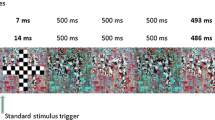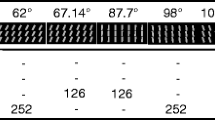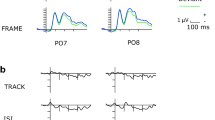Abstract
A passive three stimulus oddball paradigm was used to investigate Visual Mismatch Negativity (vMMN) a component of the Event Related Potential (ERP) believed to represent a central pre-attentive change mechanism. Responses to a change in orientation were recorded to monochrome stimuli presented to subjects on a computer screen. One of the infrequent stimuli formed an illusory figure (Kanizsa Square) aimed to capture spatial attention in the absence of an active task. Nineteen electrodes (10–20 system) were used to record the electroencephalogram in fourteen subjects (ten females) mean age 34.5 years. ERPs to all stimuli consisted of a positive negative positive complex recorded maximally over lateral occipital areas. The negative component was greater for deviant and illusory deviant compared to standard stimuli in a time window of 170–190 ms. A P3a component over frontal/central electrodes to the illusory deviant but not to the deviant stimulus suggests the illusory figure was able to capture attention and orientate subjects to the recording. Subtraction waveforms revealed visual discrimination responses at occipital electrodes, which may represent vMMN. In a control study with 13 subjects (11 females; mean age 29.23 years), using an embedded active attention task, we confirmed the existence of an earlier (150–170 ms) and attenuated vMMN. Recordings from an intracranial case study confirmed separation of N1 and discrimination components to posterior and anterior occipital areas, respectively. We conclude that although the illusory figure captured spatial attention in its own right it did not draw sufficient attentional resources from the standard–deviant comparison as revealed when using a concurrent active task.



Similar content being viewed by others
References
Astikainen P, Ruusuvirta T, Wikgren J, Korhonen T (2004) The human brain processes visual changes that are not cued by attended auditory stimulation. Neurosci Lett 368:231–234
Astikainen P, Lillstrang E, Ruusuvirta T (2008) Visual mismatch negativity for changes in orientation—a sensory memory-dependent response. Eur J Neurosci 28:2319–2324
Baudena P, Halgren E, Heit G, Clark JM (1995) Intracerebral potentials to rare target and distractor auditory and visula stimuli. III. Frontal cortex. Electroencephalogr Clin Neurophysiol 94:251–264
Berti S, Schroger E (2004) Distraction effects in vision: behavioural and event-related potential indices. Neuroreport 15:665–669
Besle J, Fort A, Giard MH (2005) Is the auditory sensory memory sensitive to visual information. Exp Brain Res 166:337–344
Czigler I (2007) Visual mismatch negativity. Violation of nonattended environmental regularities. J Psychophysiol 21:224–230
Czigler I, Csibra G (1992) Event-related potentials and the identification of deviant visual stimuli. Psychophysiology 29:471–485
Czigler I, Pato L (2009) Unnoticed regularity violation elicts change-related brain activity. Biol Psychol 80:339–347
Czigler I, Balázs L, Winkler I (2002) Memory-based detection of task-irrelevant visual changes. Psychophysiology 39:869–873
Czigler I, Balázs L, Pató LG (2004) Visual change detection: event-related potentials are dependent on stimulus location in humans. Neurosci Lett 364:149–153
Czigler I, Weisz J, Winkler I (2006) ERPs and deviance detection: visual mismatch negativity to repeated visual stimuli. Neurosci Lett 401:178–182
Czigler I, Weisz J, Winkler I (2007) Backward masking and visual mismatch negativity: Electrophysiological evidence for memory-based detection of deviant stimuli. Psychophysiology 44:610–619
Farrell DF, Leeman S, Ojemann A (2007) Study of the human visual cortex: direct cortical evoked potentials and stimulation. J Clin Neurophysiol 24:1–10
Fu S, Fan S, Chen L (2003) Event-related potentials reveal involuntary processing of orientation changes in the visual modality. Psychophysiology 40:770–775
Grice SJ, de Hahn M, Halit H, Johnson MH, Csibra G, Grant J, Karmiloff-Smith A (2003) ERP abnormalities of illusory contour perception in Williams Syndrome. Neuroreport 14:1773–1777
Hagen GF, Gatherwright JR, Lopez BA, Polich J (2006) P3a from visual stimuli: task difficulty effects. Int J Psychophysiol 59:8–14
Halgren E, Dale AM, Mendola J, Chong CDR (2003) Cortical activation to illusory shapes as measured with magnetoencephalography. Neuroimage 18:1001–1009
Heslenfeld DJ (2003) Visual mismatch negativity. In: Polich J (ed) Detection of change: event-related potential and fMRI findings. Kluwer, Dordrecht, pp 41–60
Horimoto R, Inagaki M, Yano T, Sata Y, Kaga M (2002) Mismatch negativity of the color modality during selective attention task to auditory stimuli in children with mental retardation. Brain Dev 24:703–709
Hruby T, Marsalek P (2003) Event-related potentials—the P3 Wave. Acta Neurobiol Exp 63:55–63
Inui K, Kakigi R (2006) Temporal analysis of the flow from V1 to the extrastriate cortex in humans. J Neurophysiol 96:775–784
Kaiser J, Bühler M, Lutzenberger W (2004) Magnetoencephalographic gamma-band responses to illusory triangles in humans. Neuroimage 23:551–560
Kanizsa G (1976) Subjective contours. Sci Am 234:48–52
Kimura M, Murohashi H, Ji Katayama (2006) An ERP study of visual change detection: Effects of magnitude of spatial frequency changes on the change-related posterior positivity. Int J Psychophysiol 62:14–23
Kraus N, Sharma A, McGee T, Carrell TD (1995) Neurophysiologic bases of speech discrimination. Ear Hear 16:19–37
Kremlacek J, Kuba M, Kubova Z, Langrova J (2006) Visual mismatch negativity elicited by magnocellular system activation. Vision Res 46:485–490
Maekawa T, Taniwaki T, Kinukawa N, Kanba S, Goto Y, Tobimatsu S (2005) Functional characterization of mismatch negativity to a visual stimulus. Clin Neurophysiol 116:2392–2402
Milne E, Scope A (2007) Are children with autistic spectrum disorders susceptible to contour illusions? Br J Dev Psychol 26:91–102
Molholm S, Sehatpour P, Mehta AD, Shpaner M, Gomez-Ramirez M, Ortigue S, Dyke JP, Schwartz TH, Foxe JJ (2006) Audio-visual multisensory integration in superior parietal lobule revealed by human intracranial recordings. J Neurophysiol 96:721–729
Näätänen R, Lehtokoski A, Lennes M, Cheour M (1997) Language-specific phoneme representations revealed by electric and magnetic brain responses. Nature 385:432–434
Näätänen R, Jacobsen T, Winkler I (2005) Memory-based or afferent processes in mismatch negativity (MMN): a review of the evidence. Psychophysiology 42:25–32
Pazo-Alvarez P, Cadaveira F, Amenedo E (2003) MMN in the visual modality: a review. Biol Psychol 63:199–236
Polich J (2003) Theoretical overview of P3a and P3b. In: Polich J (ed) Detection of change: event-related potential and fMRI findings. Kluwer, Dordrecht, pp 83–98
Polich J (2007) Updating P300: an integrative theory of P3a and P3b. Clin Neurophysiol 118:2128–2148
Schröger E (1997) On the detection of auditory deviations: a pre-attentive activation model. Psychophysiology 34:245–257
Schroger E, Wolff C (1998) Attentional orienting and reorienting is indicated by human event-related brain potentials. Neuroreport 9:3355–3358
Schroger E, Giard MH, Wolff C (2000) Auditory distraction: event-related potential and behavioral indices. Clin Neurophysiol 111:1450–1460
Senkowski D, Rottger S, Grimm S, Foxe JJ, Herrmann CS (2005) Kanizsa subjective figures capture visual spatial attention: evidence from electrophysiological and behavioral data. Neuropsychologia 43:872–886
Shoji H, Ozaki H (2006) Topographic change in ERP due to discrimination of geometric figures in the peripheral visual field. Int J Psychophysiol 62:115–121
Stagg C, Hindley P, Tales A, Butler S (2004) Visual mismatch negativity: the detection of stimulus change. Neuroreport 15:659–663
Tales A, Newton P, Troscianko T, Butler S (1999) Mismatch negativity in the visual modality. Neuroreport 10:3363–3367
Vogel EK, Luck SJ (2000) The visual N1 component as an index of a discrimination process. Psychophysiology 37:190–203
Wallach H, Slaughter V (1988) The role of memory in perceiving subjective contours. Percept Psychophys 43:101–106
Winkler I, Reinikainen K, Naatanen R (1993) Event-related brain potentials reflect traces of echoic memory in humans. Percept Psychophys 53:443–449
Acknowledgments
We are grateful to the anonymous referees for their critical comments and suggestions for improvements on earlier versions of the manuscript.
Author information
Authors and Affiliations
Corresponding author
Rights and permissions
About this article
Cite this article
Flynn, M., Liasis, A., Gardner, M. et al. Can illusory deviant stimuli be used as attentional distractors to record vMMN in a passive three stimulus oddball paradigm?. Exp Brain Res 197, 153–161 (2009). https://doi.org/10.1007/s00221-009-1901-7
Received:
Accepted:
Published:
Issue Date:
DOI: https://doi.org/10.1007/s00221-009-1901-7




